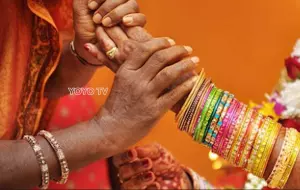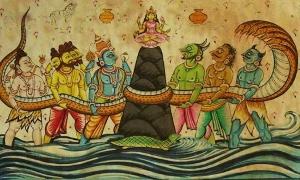Seemantham - Protecting Mother and Child With the Power of Mantra
Seemantham - Protecting the mother-to-be and her child from the physical, mental and spiritual dangers of pregnancy with powerful mantras. It promotes health and well-being for the mother and baby.
Seemantham or Seemanthonnayanam (सीमन्तोन्नयनम्) is one among the three prenatal samskaras performed in Hinduism.
It is done for a pregnant woman by her husband and is meant to benefit both the mother and the child.

What are samskaras?
Samskaras are Vedic rituals performed for spiritual and worldly progress.
They have three purposes:
- Removing a defect
- Adding a quality
- Enhancing a quality already present
Spiritual progress involves continued purification and refinement at the levels of the body, mind, and soul.
The aim is to achieve perfection and become one with Paramatma. This is called moksha.
There are many other methods also for attaining perfection such as tapas, dhyana, yajnas, and yoga.
The advantage of samskaras is that it is well-knit into day-to-day family life.
No special efforts such as relinquishing one’s own family, going to the Himalayas, or spending long hours in solitude are required.
If samskaras are properly performed, understanding their significance, then the same results of any other method of spiritual progress can be obtained.
Which are the sixteen samskaras?
- Garbhadhana
- Pumsavana
- Simantonnayana (Seemanta)
- Jatakarma
- Namakarana
- Anna-prashana
- Chaula
- Upanayana
- Vrata
- Samavartana
- Vivaha
- Pancha maha yajnas
- Paka yajnas
- Haviryajnas
- Somayagas
- Antyeshti
Out of these, Garbhadhana, Pumsavana, and Seemantha are prenatal samskaras.
What is Seemantha?
Seemantha is a short form of Seemanthonnayanam.
Seemantha - सीम्नोऽन्तः - Traditionally, married women part their hair into left and right through a line that starts from the middle of the forehead going up to the middle of the head.
This hairstyle is called Seema.
The point where this line touches the top of the forehead is Seemantha.
This is where married women apply sindoor. ( मांग भरना in Hindi)
Seemanthonnayanam - सीमन्तस्य उन्नयनं उत्तोलनं यत्र raising up of Seemantha - marking up the parting line starting from the top of the forehead in the upward direction.
This is the main ritual in Seemantha.
Hence the samsakara itself is named after this.
Essentially, Seemantonnayanam involves parting of the hair of the expectant mother into two halves.
When is it performed?
In the fourth, sixth, or eighth month of the first pregnancy, but rarely performed in the fourth.
If delivery takes place before the performance of Seemanta, it can be done post delivery also by keeping the child on the mother’s lap.
Scriptural reference
Ashwalayana Smriti says -
पत्न्याः प्रथमजं गर्भमत्तुकामाः सुदुर्भगाः।
आयान्ति काश्चिद्राक्षस्यो रुधिराशनतत्पराः॥
तासां निरसनार्थाय श्रियमावाहयेत्पतिः।
सीमन्तकरणौ लक्ष्मीस्तामावहति मन्त्रतः॥
During the first pregnancy, some Rakshasis attack desirous of eating the fetus.
The husband invokes Lakshmi Devi upon the Seemantha line to protect the wife from them.
A mantra chanted during Seemantha says:
येनादितेः सीमानं नयाति प्रजापतिर्महते सौभगाय। तेनाहमस्यै सीमानं नयामि प्रजामस्यै जरदष्टिं कृणोमि॥
Aditi is the mother of the Devas.
Prajapati (Kashyapa) had done Seemantha for her so that she and her children become prosperous and the children get a long life.
This is yet another purpose of performing Seemantha; prosperity and long life for the mother and her children.
Should Seemantha be done for every pregnancy?
According to Acharyas Bodhayana, Apastamba, and Ashwalayana, Seemanthonnayana is a Kshetra-Samskara and needs to be performed only in the case of the first pregnancy.
They have said that if the first pregnancy is purified by Seemantha, then every subsequent pregnancy shall also be pure.
The ritual
- The preparatory ceremonies such as Ganesha Puja, and Nandi shraddha to propitiate forefathers are performed.
- Homa is performed and ahutis are offered to Prajapati.
- The wife is made to sit on the West side of the homa kunda.
- Husband parts her hair using any of these: an even number of raw Udumbara fruits, a porcupine quill with three white dots on it, or three bunches of kusha grass.
- He chants the Mahavyahrits भूर्भुवस्स्वहः while doing this.
- The wife wears a small branch of the Udumbara tree or a garland made of barley around her neck. This is a symbol of fertility.
- She looks at a mix of rice, sesame seeds, and ghee. They represent wealth, progeny, and long life.
- Playing of veena is an essential part of Seemantha ceremony
- The wife gets blessed by the elders and Brahmins.
- Food is offered to everyone.
- The wife keeps silent till stars are seen in the sky.
- Then she touches a calf and says भूर्भुवस्स्वः
Meaning of Seemantha Mantras
- Prajapati is the Lord of the universe. May he provide us with wealth and fulfill all our desires.
- He created this universe. He bestows progeny. We are making this offering to him to get his blessings.
- Prajapati favors his devotees. With his blessings, may we inherit wealth that is due to us. May our wealth never deplete.
- May Prajapati bless us with children.
- Oh, Agnideva! We are meditating upon you. Please provide us with food and fame. You are our protector.
- Oh, Agnideva! Those who worship you obtain wealth, and prodigy. Please bless us. You are the fulfiller of all wishes. Make my children strong.
- May Indradeva protect us and give us wealth.
- Oh, Purnima Devi (full moon)! Make this worship complete in all respects. Bless us with children and wealth.
- Soma is our king. May our gotra prosper.
- May this woman have heroic and long-lived sons.
Benefits of Seemantha
- Protection for the mother and the baby
- Health and long life for both
- Wealth and prosperity
- Long-life for the husband
- Progress for the clan
Astrological factors
The following astrological factors are considered while fixing a muhurta for Seemantha.
- Paksha - Shukla Paksha
- Recommended tithis - 1,2,3,5,7,10,12,13
- Time - Before noon
- Recommended days - Sunday, Tuesday, Thursday
- Recommended Nakshatras - Mrigashira, Punarvasu, Pushya, Hasta, Mula, Sravana, Uttara Phalguni, Uttarashada, Uttara Bhadra, Rohini, Revati
- Recommended Lagnas - Mesha, Mithuna, Simha, Tula, Dhanus, Kumbha
What is the meaning of Seemantham?
Seemantham or Seemanthonnayanam in Sanskrit means to part the hair of a woman from the top middle of the forehead upwards. It is a prenatal samskara performed for the protection of the to-be mother and her child.
Is baby shower and Seemantham same?
A baby shower in western culture is a party given in honor of an expectant mother. Seemantham is prenatal samskara performed in Hinduism for the protection and well-being of the expectant mother and her child. Seematham involves mantras and rituals.
Quiz
Is seemantham necessary for each pregnancy?Recommended for you
पुराणों के नाम

श्रीमद्भागवत और देवीभागवत दोनों ही भागवत नाम से जाने जात....
Click here to know more..Pricchami Tva- four kinds of death explained
 Click here to know more..
Click here to know more..
Shakambhari Ashtottara Shatanamavali

asya shree shaakambharee-asht'ottarashatanaamaavalimahaamantrasya brahmaa ri'shih', anusht'upchhandah' . shaakambharee devataa . sauh' beejam . kleem ....
Click here to know more..
English Topics
Rituals
Click on any topic to open
- 74 What happens after accident or suicide deaths?
- 73 Do Homas and Yajnas still Work in Kaliyuga?
- 72 How Do Remedial Homas Work?
- 71 Hindu Beliefs About Menstruation
- 70 The Significance Of Following Rules While Observing Vratas
- 69 Tamil Brahmin Wedding Rituals
- 68 Significance Of Turmeric And Kumkum
- 67 Medicinal Properties Of Panchamrita
- 66 Tamil Brahmin Death Rituals
- 65 Dana Mantra
Please wait while the audio list loads..
30
Ganapathy
Shiva
Hanuman
Devi
Vishnu Sahasranama
Mahabharatam
Practical Wisdom
Yoga Vasishta
Vedas
Rituals
Rare Topics
Devi Mahatmyam
Glory of Venkatesha
Shani Mahatmya
Story of Sri Yantra
Rudram Explained
Atharva Sheersha
Sri Suktam
Kathopanishad
Ramayana
Mystique
Mantra Shastra
Bharat Matha
Bhagavatam
Astrology
Temples
Spiritual books
Purana Stories
Festivals
Sages and Saints
